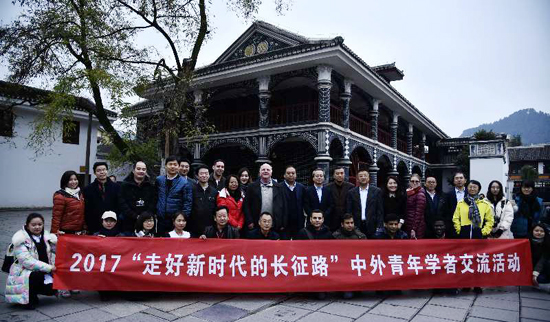
|
 |
|
A group of local and foreign journalists who were invited to witness the memorial ceremony pose for a photo in front of the Zunyi conference building on Nov 21, 2017.?[Photo provided to chinadaily.com.cn] |
An account of the history of the Communist Party of China (CPC) or to be precise modern China’s history would be incomplete without a reflection on the historical Long March, a march that was the turning point of the Communist forces (Red Army) on a courageous journey to victory against the Nationalist forces during the Chinese revolution and the total liberation of China.
Chairman Mao Zedong previously deposed from his leading position in the Communist party, according to historical accounts, regained control as leader of the party at the Zunyi Conference in 1935. Throughout much of world history, conferences or meeting of top decision makers to regroup and restrategize during wars have shaped the world we live in today. The Zunyi conference is not an exception. It not only shaped the history of modern China, but was pivotal to the rise of Mao Zedong as leader of the Communist party and the People’s Liberation Army.
In a small community in Zunyi city, formerly a county in Southwest China’s Guizhou province, the venue for the conference, located in a now bustling environment was filled with passionate members and supporters of the CPC, as well as a group of local and foreign journalists who were lucky to witness the rejuvenation and significance of the conference at a ceremony on Nov 21.
A group of local residents dressed-up in Red Army uniforms, and carried revolutionary flags to commemorate the occasion, which was attended by local government officials and leading party members of the CPC. It was an event befitting the memory of soldiers who died during the revolution to make China what it is today- a strong nation and a leader in global affairs. The leaders in their address to the audience mentioned the significance of the Zunyi conference in the Red Army’s victory against the Nationalist forces, although other meetings and stages during the revolution also played an important role in the overall liberation. From my perspective, the peace and stability enjoyed in China today is owed largely to the Zunyi conference. This was the conference that to a larger extent decided the fate of the Communist party and in the process put a small hardly noticeable city on the map of China.
The hospitality industry here is benefiting immensely from the boost in tourism as a result of the Zunyi conference venue which attracts thousands of visitors annually. A two-storey wooden building which served as the venue for the conference has been well preserved with lacquer and extra fortification to withstand the pressure exerted on the structure by teeming tourists. As part of the group of local and foreign journalists at the ceremony, I was honoured to tour the conference hall, which had all the antique furniture and settees still intact.
On the same compound, not far from the two-storey wooden building is a museum exhibiting artefacts including books, ledgers, letters, armaments and other items related to the Long March and the Zunyi conference.
At the reception area of the museum are life-size near-realistic statues of the gallant men, including Chairman Mao, who were present at the conference. It behoves me to say, that as a foreigner standing before these statues and an opportunity to commensurate the legacy of the conference with Chinese citizens, China’s opening up is now full-blown.
During the group’s tour of Zunyi city and its surrounding towns we encountered friendly local residents who told us stories of the Long March especially during their encampment in the city. An old resident, aged over 90, whom I spoke to, recalled the scene of soldiers passing through Guoba village amid encouragement by residents who sang praise to them as they marched past. He said as a young boy at the time, he remembers people in his village eager to help the soldiers in whichever way they could.
I appreciate the opportunity offered me by China Daily to learn about the history of the Zunyi conference and how it impacted on the political history of China. In a previous article I emphasised the importance of such historical sites to the education of younger generations. I would recommend that foreigners, especially students, looking to understand Chinese society should add Zunyi on their bucket list.
It goes without saying that to understand the history and development of modern China, one has to go back to the basics, and by basics I’m referring to learning about the struggle of the Chinese nation prior and during the Chinese revolution by visiting small towns and cities like Jinggang, Ruijin, Nanfeng, all in Jiangxi province, and Zunyi, Huamao, and Guoba in Guizhou province. These are some of the places that lessons of the struggle can be learned from as well as the spirit and determination of local residents, especially farmers who are the embodiment of the Chinese spirit.
The author is a former Ghanaian Journalist.